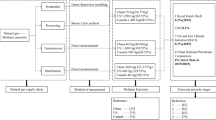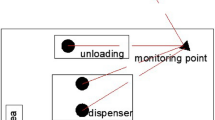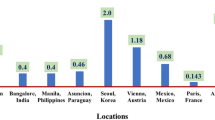Abstract
Methane, as the second most emitted greenhouse gas (GHG), has a warming potential of approximately 86 times that of carbon dioxide within 20 years. Quantifying methane emissions is helpful to the country’s emission reduction efforts. However, currently, there is a lack of measurement data of methane emissions from natural gas fueling stations in China. In this study, a downwind quantification approach was employed to directly measure the methane emissions of nine compressed natural gas (CNG) fueling stations in East China according to the Environmental Protection Agency’s Other Test Method 33A (OTM 33A). Moreover, methane concentrations were also measured near the nozzle of the refueling dispenser and the process equipment in the station. The methane emissions of the nine stations lied within the range of 0.11–0.83 kg/h, and the distribution of the emission rate was skewed. It was found that the emissions from gas fueling stations could be divided into intermittent emissions and continuous emissions, of which the intermittent emissions were the main source of methane.



Similar content being viewed by others
Data availability
The data sets supporting the results of this article are included within the article.
References
Ali NBH, Abichou T, Green R (2021) Comparing estimates of fugitive landfill methane emissions using inverse plume modeling obtained with Surface Emission Monitoring (SEM), Drone Emission Monitoring (DEM), and Downwind Plume Emission Monitoring (DWPEM). Environ Res Lett 16:054081
Anderson DC, LindsayA, DeCarlo PF, Wood EC (2021) Urban emissions of nitrogen oxides, carbon monoxide, and methane determined from ground-based measurements in Philadelphia. Environ Sci Technol 55(8):4532–4541. https://doi.org/10.1021/acs.est.1c00294
Brantley HL, Thoma ED, Squier WC, Guven BB, Lyon D (2014) Assessment of methane emissions from oil and gas production pads using mobile measurements. Environ Sci Technol 48(24):14508–14515.https://doi.org/10.1021/es503070q
Clark NN, McKain DL, Johnson DR, Wayne WS, Li H, Akkerman V, Sandoval C, Covington AN, Mongold RA, Hailer JT, Ugarte OJ (2017) Pump-to-wheels methane emissions from the heavy-duty transportation sector. Environ Sci Technol 51(2):968-976. https://doi.org/10.1021/acs.est.5b06059
Code for design and construction of filling station (GB50156–2012). http://www.jianbiaoku.com/webarbs/book/89537/2801791.shtml
Daniel Zavala-Araiza, et al (2015) Toward a functional definition of methane super-emitters: application to natural gas production sites. Environ Sci Technol 49(13):8167–8174. https://doi.org/10.1021/acs.est.5b00133
Edie R, Robertson AM, Robert A, Field J, Soltis, Dustin AS, Daniel Z, Bell CS, Vaughn TL, Murphy SM (2020) Constraining the accuracy of flux estimates using OTM 33A. Atmos Meas Tech 13(1)
Heltzel Robert S, Zaki Mohammed T, Gebreslase Aron K, AbdulAziz Omar I, Johnson Derek R (2020) Continuous OTM 33A analysis of controlled releases of methane with various time periods, data rates and wind filters. Environments 7(9):65. https://doi.org/10.3390/environments7090065
Huang X (2016) Research on risk assessment method of CNG filling station based on cloud model and entropy weight method. Southwest Petroleum University. https://kns.cnki.net/KCMS/detail/detail.aspxdbname=CMFD201701&filename=1017038080.nh
Karion A, Sweeney C, Kort EA, et al (2015) Aircraft-based estimate of total methane emission from the Barnett Shale Region. Environ Sci Technol: ES&T 49(13):8124–8131. https://doi.org/10.1021/acs.est.5b00217
Li JJ (2020) Reflections on the development of natural gas industry in China during the 14th Five-Year Plan. International Petroleum Economics 28(12):11–20.
Li N, Wang JL, Liu R, Tang X (2021) Multi-scenario conception on the development of natural gas industry under the goal of carbon neutrality. Natural Gas Industry. 41(02):183–192
Liao LB, Liu GQ (2017) Analysis and prevention of natural gas leakage in CNG filling stations. China Pet Chem Stand Qual 37(12):130–131
Lv ML (2016) Analysis of energy consumption and energy-saving application of CNG filling stations. Gas Branch of Chinese Society of Civil Engineering. Proceedings of the 2016 China Gas Operation and Safety Seminar. Gas Branch of Chinese Society of Civil Engineering: “Gas and Heat” Magazines Ltd:10
Man N, Liu F (2018) Simulation analysis of leakage and diffusion of CNG filling station. Man-Journal of Liaoning Shi Hua University. 04-0056-07:1672–6952
OTM 33A appendix f1-psg analysis sop. https://www.epa.gov//sites/default/files/2020–08/documents
Rella CW, Tsai TR, Botkin CG, Crosson ER, Steele D (2015) Measuring emissions from oil and natural gas well pads using the mobile flux plane technique. Environ Sci Technol 49(7):4742–4748. https://doi.org/10.1021/acs.est.5b00099
Saide Pablo E, Steinhoff Daniel F, Kosovic Branko, Weil Jeffrey, Downey Nicole, Blewitt Doug, Hanna Steven R, Delle Monache Luca (2018) Evaluating Methods To Estimate Methane Emissions from Oil and Gas Production Facilities Using LES Simulations. Environ Sci Technol 52(19)
State Council Information Office. Outline of the 14th Five-Year Plan for the National Economic and Social Development of the People's Republic of China and the Outline of the Vision for 2035.http://www.gov.cn/xinwen/2021-03/13/content_5592681.htm
Townsend-Small A, Hoschouer J (2021) Direct measurements from shut-in and other abandoned wells in the Permian Basin of Texas indicate some wells are a major source of methane emissions and produced water. J Air Waste Manag Assoc 70(4):410–424. https://doi.org/10.1080/10962247.2020.1728423
Wang W, Gao J, Qin H, Yang HL, **e DL (2020) Greenhouse effect, emission and control of methane. City Gas (04):4–9
Wang YD, He TB, Wang X, Wang Y, Mao D (2020a) Suggestions on the future development of natural gas vehicle industry in China. Nat Gas Ind 40(07)
Xu B, ** H, **ang Y, Duan TY, Zhang Y (2021) Analysis of natural gas consumption trend in China during the 14th Five-Year Plan. World Oil Industry 28(01):10–19
Yacovitch Ti, Herndon Sc, KJofler J et al (2015) Mobile Laboratory Observations of Methane Emissions in the Barnett Shale Region Environ Sci Technol 49(13):7889–7895. https://doi.org/10.1021/es506352j
Zavala-Araiza D et al (2017) Super-emitters in natural gas infrastructure are caused by abnormal process conditions. Nat Commun 1:1–10
Funding
Financial support from Environmental Defense Fund is received.
Author information
Authors and Affiliations
Contributions
All authors contributed to the study conception and design. Jianfeng Tang is responsible for the formulation of the overall research objectives, the proposal of the central idea of the article, the connection of the equipment and the site, and the review of the first draft. Material preparation, data collection, and analysis were performed by Yifan Wang and Fengyuan Zuo. The manuscript was written by Yifan Wang and Fei Li. The later review and revision of the article was completed by Jianfeng Tang and Donglai **e. All authors commented on previous versions of the manuscript. All authors read and approved the final manuscript. **ao Yu is mainly responsible for providing theoretical help for the manuscript and assisting in data processing. Jie Chen and Yifei Xu participated in the data measurement process.
Corresponding author
Ethics declarations
Ethical approval
Not applicable.
Consent to participate
Not applicable.
Consent for publication
Not applicable.
Competing interests
The authors declare no competing interests.
Additional information
Responsible Editor: Philippe Garrigues
Publisher's note
Springer Nature remains neutral with regard to jurisdictional claims in published maps and institutional affiliations.
Rights and permissions
About this article
Cite this article
Wang, Y., Tang, J., Li, F. et al. Measurement of methane emissions from CNG fueling stations in East China. Environ Sci Pollut Res 29, 71949–71957 (2022). https://doi.org/10.1007/s11356-022-20929-0
Received:
Accepted:
Published:
Issue Date:
DOI: https://doi.org/10.1007/s11356-022-20929-0




